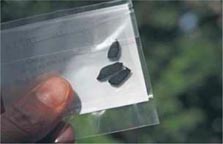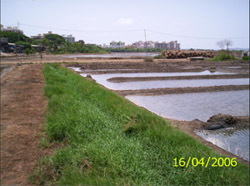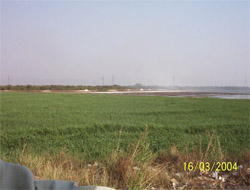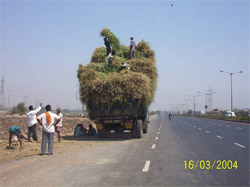
|
Conversion of Seawater and Carbon Dioxide intoBiofuel/Food and Sweet Water,using BIOSANITIZER Ecochips Process Development: This innovation has been developed through 36 years of research ‘in collaboration with Nature’ that has evolutionary experience (know-how) of about 5 billion years. To facilitate this ‘learning from Nature’ an Eco-Logic (grammar of Nature’s language) was developed. Eco-Logic can be stated as:
Following were the threads of thinking that led to further development:
The Technology: Using the above logic, Bhawalkar Ecological Research Institute (BERI), located at Pune (India), developed the BIOSANITIZER Ecochip. Ecochip is ‘ecology on a chip’. 100 mg of BIOSANITIZER Ecochip has the same capability as 1 acre of natural forest, of using inorganic nutrients(salts) and CO2 as food and produce eco-resources (food/fuel and oxygen).
Inorganic pollution (N, P, sulphates, chlorides, sodium, heavy metals, etc.) get reduced through utilization as ‘food for plants’. This action also needs import of warmth and CO2 if it is not available in the system. This method of converting wastes into resources is common feature of Nature. To see the case studies where salts were remediated, please visit www.ecochip.org. Saline tracts of groundwater have been remediated by putting BIOSANITIZER Ecochips, into the bore-wells. We have also created about 1,000 acres of commercial grass farming in Mumbai, using BIOSANITIZER treated sewage and seawater. We are now looking for a commercial project for ‘bioconversion of seawater into food/fuel and sweet water’.
About the Innovator: The innovator is the director of Bhawalkar Ecological Research Institute (BERI), Pune. He is a B. Tech., chemical engineering, from IIT Bombay. After spending 14 years in contact with Nature (in rural area), he registered for his PhD in chemical engineering, again at IIT Bombay. Received his doctorate after 24 years of fieldwork, in the field of ecology and ecological engineering. He has 2 Indian and 1 US patent to his credit. He has traveled widely in 12 countries to promote his latest creation, that of BIOSANITIZER Ecochips. 1. Entry Overview: Fuels for modern vehicles and industries, and food (fuel for man and his domesticated animals) are getting scarce and hence costly each year. These have been produced through mining that cannot be sustainable. Even the modern food production system through intensive agriculture, is based on mining of soil organic matter and hence not sustainable. This innovation helps us produce sustainable biofuel and food without any mining activity. In fact, the process uses two prominent sources of pollution, viz. salinity of soil and water (ground or surface water) and carbon dioxide, which is a well-discussed greenhouse gas (pollutant) that causes global warming. There are no major operating expenses in this new process because laws of ecology and ecological engineering are understood and observed. This makes the process economically attractive. After all, laws of both ecology and economy are similar. Recession invariably results when we do not follow them. 2. Value Proposition: Salty ground or surface water cannot be used for drinking, washing or agriculture/industries. Current methods of desalination need large investment and huge operating expenses. The reject stream(that can be up to 50% of the volume of the input stream), also poses disposal problems because of high TDS. High TDS waste stream can also harm the ecology. BIOSANITIZER Ecochips have been used by farmers, industries and urbanites, to treat the brackish or salty ground and surface water/wastewater. These beneficiaries have appreciated the technology for the past 12 years and promoted it to others. 3. Market Adoption: BIOSANITIZER Ecochips have been used by farmers, industries and urbanites, to treat the brackish or salty ground and surface water/wastewater on actual field scale projects. Water scarcity was the driving force that led to adoption of this novel method. Water sources that were unusable, could be made usable with this method with no operating expenses. Such ‘niche marketing’ was found successful. 4. Leadership Position: Leadership was, thus, created by creating ‘niche’ in the water/wastewater treatment sector where there are only the separation technologies that only create a stream of higher strength and higher disposal problems. Smaller investment, negligible recurring expenses and eco-friendly nature of the technology, were sold as unique selling proposition(USP). The technology was promoted by presenting papers in conferences. Media(print, audio, video and internet) was very much helpful, to spread the message. Each beneficiary also acted as an ambassador of the technology that has been derived ‘in collaboration with Nature’. Strategic partnership/relationship with Indian Water Works Association(IWWA), a technical body of municipal engineers who have to supply clean treated water to the people and also take care of wastewater treatment and disposal, evolved logically because the innovation can reduce their headaches and make their job more pleasant. Association with several schools, colleges and universities also made the technology propagation simpler and speedier. International agencies such as UNEP, UNICEF, World Bank and others, were also helpful in testing the technology in several countries with different agro-climatic zones. Executive Summary: BIOSANITIZER Ecochips (bio-catalyst) help us utilize three pollutants (salts, carbon dioxide and warmth) as free raw materials. BIOSANITIZER makes the salts usable, as nutrients for the plants. Salty water, thus, can be utilized to grow crops that produce food, fuel, etc. Shallow wells, then are used to collect the sweet water. Carbon dioxide from the air also gets sequestered during the process. Economic recession, thus, can be resolved through creation of eco-jobs using this innovation.
|
|
|||||||||||||||||||||||||||||||||||||||||||||||||||||
©Copyright
|
Pamphlet :: Summary :: Cleaning Ganga :: Lead Article:::Lead Paper :: Lead Poster :: Methodology Articles :: Articles :: Presentations :: US Patent :: Projects :: Katrina :: Publications :: Contact us :: Home |





